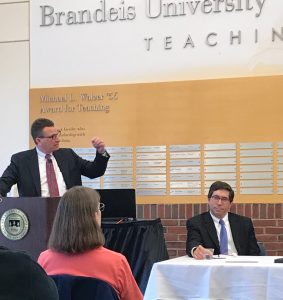Financially, the university is “secure” but “constrained” and needs to generate higher revenue to achieve goals, according to members of Brandeis’ Finance and Administration senior leadership team, who held an open meeting on Wednesday in the International Longue to address the financial sustainability and provide updates for ongoing campus projects.

Stew Uretsky, executive vice president for Finance and Administration, began with an overview of university finances and future goals. The top ten goals for finance and administration in the 2018 fiscal year include developing plans for reviewing university finances, ensuring stability and addressing issues such as divestment, campus construction, deferred maintenance and staff benefits.
Uretsky hopes the financial side of the institution will be seen as a “trusted partner” and an “agent of change” in service to the academic community of Brandeis. Uretsky praised President Liebowitz’s “strong leadership” in supporting the ten 2018 fiscal goals. The financial leadership team will make push to be more transparent in achieving their goals, said Uretsky. Uretsky cited the open meeting itself as a show of transparency.
Residence hall construction and deferred maintenance
Construction of the new residence hall in place of Usen Castle is on schedule and on budget, confirmed Jim Gray, the vice president for campus operations. Brandeis took out a $50 million bond to finance the project. Uretsky revealed at the open meeting that only $40 million will actually be devoted to that project. The other $10 million will go towards deferred maintenance.
Deferred maintenance refers to upkeep and updating that need to take place around campus. Forty-six percent of the buildings on campus are over the age of 50, and 33 percent of buildings are between 25 and 50 years old.
In 2015, the university found its buildings use 25 percent more energy than comparable schools, based on building characteristics and climate, according to Brandeis’ Climate Action Plan.
A large amount of Brandes’ emissions come from building energy use, according to a November 2016 Hoot article, which relates to their age and lack of efficiency. Investing in more efficient windows, roofs or mechanical systems could help improve this, according to the plan.
The oldest building envelopes are “crumbling,” according to Gray, but the university does not currently have the money to fix all of them.
The Heller School is the only building from the post-war era that has been updated. Gray offered a preliminary list of building updates for the 2019 fiscal year project plans.
Financial standing and understanding
Over the summer, the Finance and Leadership team began combining budget models to create one that better suited the functionality of the university. Brandeis is a people-driven-institution, according to Sam Solomon, the Chief Financial Officer. Fifty-seven percent of the university’s total revenue is student-driven, meaning that tuition and housing makes up over half of Brandeis’ annual revenue. In terms of annual expenses, the salaries and benefits of staff and faculty make up over half of all expenditures. “We are a people driven business,” Solomon concluded.
Brandeis does not have a lot of room to raise tuition on top of current increases, according to Solomon. The cost of attendance needs to stay similar to comparative universities for Brandeis to remain attractive to prospective students. Solomon recognized that a high cost of attendance can deter students who have trouble navigating financial aid forms.
In a list of comparable institutions, Brandeis has the second highest cost of attendance at $68,443. The University of Pennsylvania costs slightly more, ringing in at $68,600, and New York University costs slightly less at $68,400. The median cost of attendance for comparable universities listed in Solomon’s presentation is $67,897, making Brandeis about $500 more expensive than the median cost.
The university is running with a surplus of $1.2 million, which is considered small, but higher than the $1 million surplus from the 2016 fiscal year. The surplus is not enough for the university to achieve some long term goals associated with its mission statement, Solomon explained.
The endowment is projected to grow, but that growth might be negligible based on current spending levels, according to Solomon. Brandeis has done a lot to increase donor contributions, but matches the higher contributions with increased spending. “It’s a testament to the ability that everyone here at Brandeis has… to raise money but we need to actually store that money better and preserve the purchasing power of that endowment.”
“The good news is, we are financially secure, but we are constrained and we need to look for new ways to do things,” said Solomon.
Divestment
The Board of Trustees will discuss the possibility of divesting the university endowment from fossil fuels in January, said Uretsky. Faculty voted to support divestment on Oct. 20 during a monthly faculty meeting, and on Nov. 17 students and faculty marched across campus to demonstrate support for divestment.
Staff benefits review
Listed in the top 10 goals is a review of the benefits and wellness program offered to staff and faculty. As of Nov. 30, the program does not include paid parental leave or a 457B program. Finance and Administration added vision to the benefits package this year. A review of the overall program will continue over the next few years, according to Uretsky. Members of Finance and Administration have already begun reviewing the existing retirement plan.
Staff advisory council
Finance and Administration successfully launched a staff advisory council about a week ago which will seat staff elected from 13 newly created districts on campus. Councilmembers will represent the interests of their districts to help Finance and Administration make informed decisions. This change is part of an effort to increase communication levels between departments on campus.
Information and technology services updates
The university currently runs PeopleSoft, a software that offers human capital management business solutions. PeopleSoft is over 20 years old, which means “there are large security risks involved with continuing to run a system that’s outdated,” said Gray.
After receiving input from about 200 staff members across campus and viewing two demonstrations from different companies, ITS decided to implement Workday as the new software platform.
The Workday implementation will take place in two phases. Phase one began this semester and will run through Oct. 2018. That phase handles Human Capital Management and Finance, Grants and Gifts. The second phase, transitioning student systems to Workday, will begin Jan. 2019 and is projected to conclude April 2020.
A forum concerning the switch over to this new system will be held on Dec. 12.


